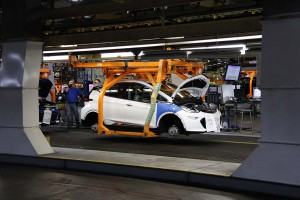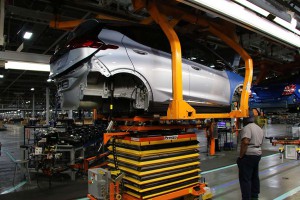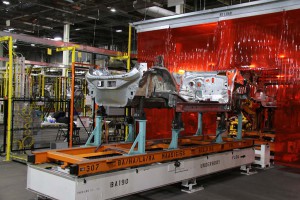With the plant running at only about a third of its capacity, General Motors has dimmed the lights at much of its Orion Township Assembly Plant, save for one final station near the end of the production line. There, in a booth lit as brightly as a mid-summer’s day, a couple of hourly workers are carefully inspecting a Chevrolet Bolt hatchback.
They’re determined to make sure all the sheet metal and chrome fit together as planned, and that there are no nicks or scratches to the paint. GM can’t afford any mistakes. The Chevy Bolt EV could prove to be one of the most important products the Detroit-based automaker has launched in decades.
The first long-range, affordably priced battery-electric vehicle isn’t likely to generate six-figure sales. Nonetheless, it will not only demonstrate whether there’s a mainstream market for EVs but also show whether GM can appeal to the sort of buyers who have largely flocked to either imports or new start-ups like Tesla.
(Chevy Bolt named Green Car of the Year. Click Here to learn why.)
For now, GM officials will only say they plan to sell the first Bolt to a retail customer “before the end of the year.” But since retail-ready models began rolling down the line last month, they have been rapidly ramping up production. The Orion plant produces about 45 cars an hour on a single shift. Right now, about two-thirds of those are the conventionally powered Chevrolet Sonics. But that means more than 100 Bolts are rolling out of the plant each day.
“We’re still accelerating production,” says Yves Dontigny, the Bolt Launch Manager, as he leads a group of journalists through the Orion plant.
The fact that both the Bolt and the Sonic are built on the same line helps keep costs down, a critical step in making it possible to sell the 200-mile battery-car at a starting price of $37,495 – before a $7,500 federal tax credit. In years past, GM might have needed a separate line or, at the least, it might have diverted the Bolt off the main assembly line to handle unique operations.
But doing that meant “we had to develop new techniques, especially when it came to the drive modules,” the Canadian-born Dontigny explains, adding that during the initial development of the Bolt members of the production team worked closely with GM engineers to ensure there wouldn’t be any unexpected snags at the plant.
Dontigny pauses at one of hundreds of work stations along the serpentine line. As a Chevy Sonic moves into position, two workers maneuver a cart into place that carries the hatchback’s gas tank. In a process as carefully choreographed as a ballet, they slip the tank into the vehicle, then firmly bolt it into place before the partially completed car moves onto the next workstation.
Moments later, a Bolt swings into place, hanging from a claw-like carrier. As it does, an automated cart rolls into place beneath the EV carrying an 800-pound battery pack. The workers trigger the carrier to rise up, marrying pack and body. Six bolts later, the process is complete. The battery-car rolls on.
“There’s more capacity in this plant,” says Dontigny. In fact, GM could roughly triple the factory’s output by adding up to two more shifts. And there’s enough space to add an additional line, if needed.
For now, however, the carmaker is taking a cautious approach. It remains to be seen how much demand there will be for the Bolt EV – indeed, for any electric vehicle in the mainstream market. Though GM isn’t talking numbers, an executive with its Korean battery supplier LG Chem earlier this year suggested it was gearing up to provide enough battery packs for about 30,000 Chevrolet Bolts in 2017.
Some observers think GM is being too cautious. They note that rival Tesla has already taken about 400,000 advanced registrations – including $1,000 deposits – for the similarly priced Model 3 it hopes to launch in late 2017. But industry analysts stress that Tesla has a high-tech image that Chevrolet sorely lacks. The Detroit maker will have to prove that it can deliver an equally cutting-edge product.
And that’s why GM is determined to make no mistakes. It is carefully inspecting every car coming off the line and capturing hundreds of finished Bolts to run through a captive corporate test fleet. Company employees have already logged hundreds of thousands of miles in the new battery-electric vehicle.
But the real test will begin in a matter of days, if not weeks. Fleets of car carriers have been heading from Michigan to dealers in California in recent weeks, sales set to begin in the green-minded Golden State before going nationwide.
(Will the Trump Administration unplug EVs? Click Here for more.)
GM is believed to have spent more than $1 billion developing the Bolt. But the underlying components will be used in other products to come – including a European version, dubbed the Opel Ampera-e that will debut in 2017.
The good news for Chevy is that Bolt is already receiving strong kudos. Among other things, it has been named both Motor Trend Car of the Year and Green Car of the Year. And it is one of three finalists for North American Car of the Year, that winner set to be announced on January 9th.
Such awards will certainly draw attention to the Chevy Bolt, but it will likely be word of mouth that really makes a difference. And that will only begin when the first of the battery-cars start rolling out of dealer showrooms.
(Major automakers teaming up on super-fast EV charging project. Click Here for the story.)



